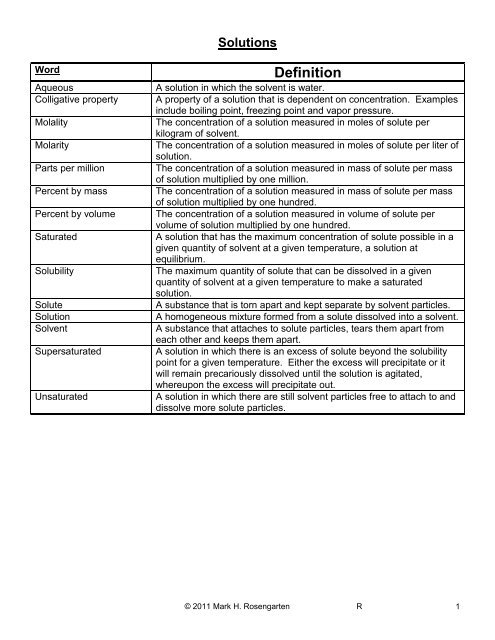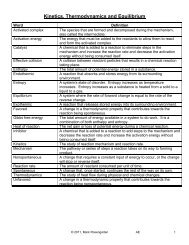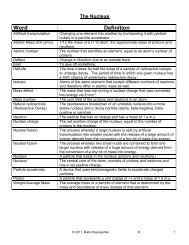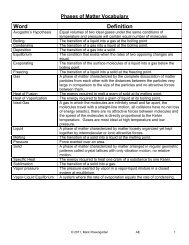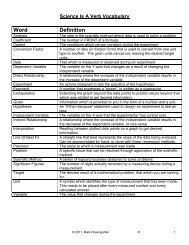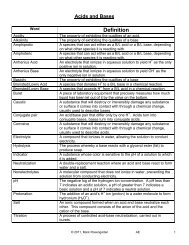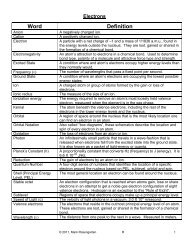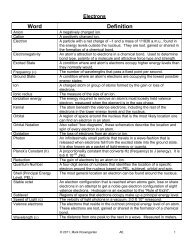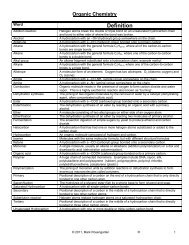Solutions - Mark Rosengarten
Solutions - Mark Rosengarten
Solutions - Mark Rosengarten
Create successful ePaper yourself
Turn your PDF publications into a flip-book with our unique Google optimized e-Paper software.
<strong>Solutions</strong><br />
Word<br />
Aqueous<br />
Colligative property<br />
Molality<br />
Molarity<br />
Parts per million<br />
Percent by mass<br />
Percent by volume<br />
Saturated<br />
Solubility<br />
Solute<br />
Solution<br />
Solvent<br />
Supersaturated<br />
Unsaturated<br />
Definition<br />
A solution in which the solvent is water.<br />
A property of a solution that is dependent on concentration. Examples<br />
include boiling point, freezing point and vapor pressure.<br />
The concentration of a solution measured in moles of solute per<br />
kilogram of solvent.<br />
The concentration of a solution measured in moles of solute per liter of<br />
solution.<br />
The concentration of a solution measured in mass of solute per mass<br />
of solution multiplied by one million.<br />
The concentration of a solution measured in mass of solute per mass<br />
of solution multiplied by one hundred.<br />
The concentration of a solution measured in volume of solute per<br />
volume of solution multiplied by one hundred.<br />
A solution that has the maximum concentration of solute possible in a<br />
given quantity of solvent at a given temperature, a solution at<br />
equilibrium.<br />
The maximum quantity of solute that can be dissolved in a given<br />
quantity of solvent at a given temperature to make a saturated<br />
solution.<br />
A substance that is torn apart and kept separate by solvent particles.<br />
A homogeneous mixture formed from a solute dissolved into a solvent.<br />
A substance that attaches to solute particles, tears them apart from<br />
each other and keeps them apart.<br />
A solution in which there is an excess of solute beyond the solubility<br />
point for a given temperature. Either the excess will precipitate or it<br />
will remain precariously dissolved until the solution is agitated,<br />
whereupon the excess will precipitate out.<br />
A solution in which there are still solvent particles free to attach to and<br />
dissolve more solute particles.<br />
© 2011 <strong>Mark</strong> H. <strong>Rosengarten</strong> R 1
Topic 1) <strong>Solutions</strong> and Solubility (HW: p. 13, 14)<br />
Essential Questions: Why doesn’t oil mix with water? Why does sugar dissolve better in hot water than cold?<br />
Why do you have to be careful of the temperature you keep your fish tank at?<br />
Mixtures: made from physically mixing two or more substances together without a chemical reaction occurring.<br />
Mixing ionic compounds with water forms aqueous solutions of dissolved ions. The polar water molecules attract to<br />
the ions, tearing them apart from other ions and holding them away from other ions. This is called molecule-ion<br />
attraction.<br />
© 2011 <strong>Mark</strong> H. <strong>Rosengarten</strong> R 2
SOLUBILITY: The quantity of solute that can be added to a quantity of solvent to make a saturated solution at a<br />
given temperature and pressure.<br />
Saturated: The solution holds as many dissolved particles as it can possibly hold (100-seat restaurant that has 100<br />
people in it). In a saturated solution, all the solvent (water) molecules are occupied with keeping ions apart, so no<br />
more are available to do any more dissolving. Any further added solute will sink to the bottom of the container as a<br />
precipitate.<br />
Unsaturated: The solution holds fewer solute particles than can theoretically be dissolved (100 seat restaurant with<br />
40 people in it), can add more solute. There are still free solvent molecules available to dissolve more added solute.<br />
Supersaturated: A very rare situation where the solution holds more solute than is theoretically possible, unstable<br />
situation where the excess will precipitate if the solution is agitated (100-seat restaurant with 120 people, when the<br />
manager comes in, he throws the extra 20 people out).<br />
FACTORS AFFECTING SOLUBILITY:<br />
1) Temperature<br />
a) For solid and liquid solutes, solubility in water increases as temp increases<br />
Effect of temperature on solubility of a solid solute in water: An example of this is the sugar water needed to<br />
make rock candy. A saturated solution is formed at high temperature. As the temperature cools, the sugar becomes<br />
less soluble, so water molecules holding some sugar molecules apart from each other have to jump off to assist other<br />
water molecules in keeping sugar molecules apart. The released sugar molecules re-form a crystal structure, a solid<br />
precipitate that grows slowly, that forms the rock candy crystal that is so yummy.<br />
b) For gaseous solutes, solubility in water decreases as temp increases<br />
Effect of temperature on solubility of a gas solute in water: An example of this is dissolved oxygen in a fishtank.<br />
Fish need dissolved oxygen to breathe, so it is bubbled into the tank. Gases hate being dissolved in water, because<br />
this forces their entropy to decrease, which is unfavored by nature. Increasing the temperature makes the entropy<br />
increase, which makes the gas even less likely to dissolve. At high temperatures, very little oxygen can dissolve.<br />
Tropical fish either have to have large gills to extract the small amount of dissolved oxygen from the water or have<br />
evolved to require less oxygen to survive. Cold-water fish don’t need gills that are as large, because oxygen is more<br />
soluble in colder water.<br />
2) Pressure<br />
a) For gaseous solutes, solubility increases as pressure increases<br />
In soda machines, water traveling through a tube gets flavored syrup added to it as well as carbon dioxide. Since<br />
gases hate being dissolved in water, it requires a great deal of pressure to get the carbon dioxide into the water.<br />
When a soda bottle is opened, the pressure decreases, releasing the carbon dioxide gas. If the soda bottle is left<br />
open, virtually all of the gas will escape, leaving the soda flat. CO 2 gas is soluble at high pressures and nearly<br />
insoluble at low temperatures.<br />
b) Pressure does not affect solid or liquid solutes.<br />
3) Nature of Solute and Solvent (Like Dissolves Like)<br />
a) Polar solutes dissolve in polar solvents<br />
Water, being polar, has partially charged ends that can attract polar or ionic solutes. This is why ionic solutes like salt<br />
and polar molecular solutes like sugar can be dissolved in water.<br />
Water, being polar, has no attraction for nonpolar molecular solutes like oil. The oil will simply float on top of the water.<br />
This is why water should never be used to put out a grease or oil fire, the oil will simply float on top of the water and<br />
continue to burn, and the risk is great that the fire will spread. This is another reason why gases such as CO 2 and O 2<br />
are not very soluble in water, since these gases are nonpolar!<br />
© 2011 <strong>Mark</strong> H. <strong>Rosengarten</strong> R 3
) Nonpolar solutes dissolve in nonpolar solvents<br />
While oil will not dissolve in water, it will dissolve very nicely in a nonpolar organic solvent called benzene. Benzene,<br />
C 6 H 6 , is as good dissolving nonpolar solutes as water is at dissolving polar solutes. The enamel in nail polish is also<br />
nonpolar, and can be nicely dissolved with another nonpolar solvent, acetone. Nail polish remover is made of acetone<br />
and nail polish itself is a solution made of enamel dissolved in acetone. When the nail polish is painted on the<br />
fingernail, the acetone evaporates, leaving the enamel behind on the nail as a precipitate. There are non-acetone nail<br />
polish removers available, they are just other nonpolar solvents.<br />
USING REFERENCE TABLE G (up curves represent SALTS, down curves represent GASES)<br />
Reference Table G: Solubility Curves can be used to determine the following:<br />
a) Solubility of a solute in 100 grams of water at various temperatures<br />
Each line on this table represents a saturated solution of a solute at different temperatures. The higher a line is at a<br />
given temperature, the more soluble it is. The data given tells us how many grams of solute can be dissolved in 100<br />
grams of water at a particular temperature. If you want to know how many grams of solute can dissolve in any amount<br />
other than 100 grams of water, find out how much can dissolve in 100 grams of water first, and then set up a<br />
proportion.<br />
© 2011 <strong>Mark</strong> H. <strong>Rosengarten</strong> R 4
) Degree of saturation (unsaturated, saturated or supersaturated)<br />
© 2011 <strong>Mark</strong> H. <strong>Rosengarten</strong> R 5
What if you have an amount of water that is different from the 100g on the Reference Table?<br />
Reference Table G shows solubility data assuming that a 100-gram sample of water is used to dissolve the solute.<br />
Because of the miracles of proportionality, one does not need a separate reference table for every possible amount of<br />
water used! For example, if the solute is dissolved in 50 g of water, that is half as much solvent, so half as much<br />
solute can be dissolved!<br />
1) Figure out your amount of grams of solute per 100 grams of water.<br />
2) Use a proportion to determine the grams of solute per how ever much water you have!<br />
3) This gives you the grams of solute for any amount of water you might have!<br />
How many grams of NaNO 3 are required to make a saturated<br />
solution in 100 g of water at 30 o C?<br />
Start at 30 o C, move up to the NaNO 3 line. Scoot across to Solute<br />
(g). 96 grams can be dissolved in 100 g of water at 30 o C.<br />
How many grams of NaNO 3 are required to make a saturated<br />
solution in 50 g of water at 30 o C?<br />
Since in the last question, it was determined that 96 grams of<br />
NaNO 3 can be dissolved in 100 g H 2 O, since 50 g is half as much<br />
water, only half as much NaNO 3 can be dissolved. Therefore,<br />
96/2 = 48 g of NaNO 3 can be dissolved in 50 g H 2 O.<br />
How many grams of NaNO 3 are required to make a saturated<br />
solution in 200 g of water at 30 o C?<br />
Since in the first question, it was determined that 96 grams of<br />
NaNO 3 can be dissolved in 100 g H 2 O, since 200 g is twice as<br />
much water, twice as much NaNO 3 can be dissolved. Therefore,<br />
96 X 2 = 192 g of NaNO 3 can be dissolved in 200 g H 2 O.<br />
What is the solubility of HCl in 100 g of water at 70 o C?<br />
Start at 70 o C, up to HCl and across: 52 g HCl in 100 g H 2 O @<br />
70 o C<br />
What kind of solution do you have if 80 grams of KClO 3 are dissolved in 100 g of water at 40 o C?<br />
Start at 80 grams, and 40 o C. See where the lines intersect with respect to the KClO 3 line. They intersect far above the<br />
KClO 3 line. At 40 o C, the solubility of KClO 3 is only 16 grams in 100 g of water. This solution is supersaturated.<br />
For the above solution, what can you do with temperature and amount of KClO 3 to make the solution<br />
saturated?<br />
If you want to dissolve 80 g of KClO3 in 100 grams of water, the table says you need to heat the solution to 75 o C<br />
(adding an additional 35 o C to the current temperature of 40 o C).<br />
Since KClO 3 has a solubility of only 16 grams in 100 g of water, and the solution contains 80 grams, the excess<br />
precipitates out. 80 g – 16 g = 64 grams of precipitate will fall out of the solution, leaving a saturated solution<br />
behind.<br />
At what temperature do HCl and NH 4 Cl have the same solubility? Their solubility lines intersect at 57 o C.<br />
© 2011 <strong>Mark</strong> H. <strong>Rosengarten</strong> R 6
Topic 2) Concentration (HW: p. 15, 16)<br />
Essential Question: How do EPA standards keep our drinking water safe?<br />
CONCENTRATION - a measure of the amount of substance per unit volume.<br />
For solutions, there are several expressions of concentration:<br />
1) Grams of solute/100 mL of solvent (Ref. Table D)<br />
This is what you did yesterday when determining the solubility of a solute in water.<br />
2) Molarity (M) = moles of solute/L of solution<br />
This is the most commonly used unit of concentration in the laboratory.<br />
A) To experimentally determine the molarity of a solution,<br />
1) Determine the volume of solution you have<br />
2) Determine how many moles of solute are dissolved in the solution by<br />
a) Evaporating off the solvent<br />
b) Weighing the solute<br />
c) Dividing the mass of the solute by the formula mass of the solute<br />
3) Molarity (M) = moles of solute/L of solution.<br />
What is the molarity of a solution if it contains 2.0 moles of KNO 3 in 4.0 L of solution?<br />
M = moles of solute/L of solution = 2.0 moles / 4.0 L = 0.50 M, which can also be written 0.50 moles/L.<br />
What is the molarity of a solution if it contains 2.0 moles of NaCl in 250. mL of solution?<br />
1) First, 250. mL must be converted to L: (250.) mL / (1000 mL/L) = 0.250 L<br />
2) M = moles of solute/L of solution = (2.0 moles) / (0.250 L) = 8.0 M, which can also be written 8.0 moles/L.<br />
What is the molarity of a solution if it contains 20. grams of NaOH in 2.0 L of solution?<br />
1) First, 20. grams of NaOH must be converted to moles: (20. g) / (40.0 g/mole) = 0.50 moles<br />
2) M = moles of solute/L of solution = (0.50 moles) / (2.0 L) = 0.25 M, which can also be written 0.25 moles/L.<br />
What is the molarity of a solution if it contains 60. grams of NaOH in 400. mL of solution?<br />
1) First, 60. grams of NaOH must be converted to moles: (60. g) / (40.0 g/mole) = 1.5 moles<br />
2) Then, 400. mL must be converted to L: (400.) mL / (1000 mL/L) = 0.400 L<br />
3) M = moles of solute/L of solution = (1.5 moles) / (0.400 L) = 3.8 M, which can also be written 3.8 moles/L.<br />
© 2011 <strong>Mark</strong> H. <strong>Rosengarten</strong> R 7
B) To make a specific volume of solution with a desired molarity,<br />
The equation M = moles/L can be rearranged to solve for moles: moles = M X L<br />
1) Determine the desired concentration (what is the molarity of the solution you are trying to make?)<br />
2) Determine how much solution you want to make (how many L of solution do you need to make?)<br />
3) Multiply the two. This will give you moles. (M X L = moles. If you are given mL, convert to L first)<br />
4) Determine the formula mass of the solute. (FM = sum of atomic masses of all atoms in the compound, to the<br />
tenths<br />
place)<br />
5) Multiply the number of moles of solute calculated in step 3 by the formula mass of the solute. This will tell<br />
you how many grams of solute are needed. (moles X formula mass = grams)<br />
6) Mix with enough solvent to make the desired volume of solution. This is usually carried out in a volumetric<br />
flask.<br />
Who needs to do this? I, your chemistry teacher, needs to do this, every time I make a solution for you to use in lab.<br />
Anyone who works with chemicals needs to do thismedical, biological, geologicalany profession that uses<br />
solutions will involve using this calculation. It is actually one of the most practical calculations you are learning in this<br />
course!<br />
How many grams of NaOH are needed to make 4.0 L of a 0.50 M solution of NaOH?<br />
First, determine how many moles are needed: Moles = M X L = (0.50 moles/L) X (4.0 L) = 2.0 moles of NaOH<br />
Then, convert moles to grams: (2.0 moles) X (40.0 g/mole) = 80. grams of NaOH are needed.<br />
So, now you can weigh out 80. grams of NaOH on a triple-beam or digital balance and put it into a 4.0 L volumetric<br />
flask and fill it to the top line with distilled water.<br />
How many grams of KCl are needed to make 500. mL of a 0.100 M solution of KCl?<br />
First, convert the 500. mL to L: (500. mL) / (1000 mL/L) = 0.500 L<br />
Second, determine how many moles are needed: Moles = M X L = (0.100 moles/L) X (0.500 L) = 0.0500 mol of NaOH<br />
Then, convert moles to grams: (0.0500 moles) X (74.6 g/mole) = 3.73 grams of KCl are needed.<br />
So, now you can weigh out 3.73 grams of KCl on a triple-beam or digital balance and put it into a 500. mL volumetric<br />
flask and fill it to the top line with distilled water.<br />
3) Parts Per Million (ppm) = (grams of solute/grams of solution) X 1 000 000<br />
Used to determine trace amounts of dissolved ions in drinking water. Established toxic threshold levels are reported in<br />
ppm or sometimes ppb (parts per billion) if it is a particularly nasty toxin. It is also used to measure the concentration<br />
of particulates in the air. Air pollution is measured in parts per million, as is dust in a clean room at an electronics<br />
manufacturing plant.<br />
What is the concentration, in ppm, of lead ions in 100. g of tap water with 0.0000450 g of lead ions dissolved in<br />
it?<br />
ppm = (g of solute / grams of solution) X 1 000 000 = {(0.0000450 g) / (100. g)] X 1 000 000 = 0.45 ppm<br />
© 2011 <strong>Mark</strong> H. <strong>Rosengarten</strong> R 8
A well is drilled on some property nearby a landfill to determine its suitability for supplying water for proposed<br />
new homes. When tested, it is found that a 1.000 kg (1000. gram) sample of water taken from this well<br />
contains 0.00330 grams of cadmium. Cadmium is a toxic heavy metal leached out of rechargeable batteries<br />
that people often throw out with the trash instead of recycling.<br />
What is the concentration, in ppm, of cadmium ions in this tap water?<br />
First, ppm is measured in GRAMS, so convert 1.00 kg to g: (1.000 kg) X (1000 g/kg) = 1000. g<br />
Then, ppm = (g of solute / grams of solution) X 1 000 000 = {(0.00330 g) / (1000. g)] X 1 000 000 = 3.30 ppm<br />
The Environmental Protection Agency has set a legal limit of 0.005 ppm for cadmium ion concentration for<br />
drinking water. 3.30 ppm far exceeds this limit, therefore, any well tapping into this water supply cannot be<br />
used, and a house that gets its water supply from this<br />
What is the concentration, in ppm, of a solution containing 5.0 grams of solute dissolved into 250. grams of<br />
water?<br />
This situation is slightly different. Here, you are not told the total mass of the solution, but the mass of each of its<br />
parts. To get the total mass of the solution, you must add the mass of the solute (2.0 grams) and the mass of the<br />
solvent (250. grams) together. The mass of the solution is 255 grams.<br />
ppm = (g of solute / grams of solution) X 1 000 000 = {(5.0 g) / (250. g)] X 1 000 000 = 20 000 ppm<br />
A 50.0 gram sample of solution is evaporated to dryness. If the concentration of solute in the original solution was<br />
25.0 ppm, what is the mass of solute that is left after the solvent has been evaporated away?<br />
OK, now you need some algebra. You know the concentration in ppm, you know the mass of the solution. Rearrange<br />
to find the mass of the solute:<br />
ppm = (g of solute / grams of solution) X 1 000 000 g of solute = (ppm X grams of solution) / 1 000 000<br />
g solute = (25.0 ppm X 50.0 g) / 1 000 000 = 0.00125 grams of solute in the original solution<br />
4) Percent by Mass = (grams of solute/grams of solution) X 100<br />
A 25.0 gram sample of an aqueous NaCl solution is evaporated and found to contain 2.0 grams of NaCl. What<br />
is the percent by mass of NaCl in this solution?<br />
% by mass = (grams of solute/grams of solution) X 100 = [(2.0 g) / (25.0 g)] X 100 = 8.0% NaCl by mass<br />
5) Percent by Volume = (mL of solute/mL of solution) X 100<br />
Percent by volume is often used to describe the concentration of alcohol in alcoholic beverages or in medications<br />
containing alcohol. Wine is often 14% alcohol by volume, and 50% or greater alcohol by volume (100 proof) is actually<br />
flammable. This is where the term proof comes fromback in the old days, a bartender might water down the whiskey<br />
to save money. Whiskey was supposed to be at least 50% alcohol by volume. If a patron demanded proof that the<br />
whiskey wasn’t watered down, a sample had to be touched with a flame. If it wouldn’t burn, the bartender might be<br />
shot! Or just run out of business.<br />
A 50.0 mL sample of an aqueous ethanol solution is distilled to yield 33.2 mL of ethanol. What is the percent<br />
by volume of ethanol in this solution?<br />
% by volume = (mL of solute / mL of solution) X 100 = [(33.2 mL) / (50.0 mL)] X 100 = 66.4% ethanol by volume<br />
© 2011 <strong>Mark</strong> H. <strong>Rosengarten</strong> R 9
Topic 3) Colligative Properties (HW: p. 17, 18)<br />
Essential Questions: How does antifreeze work? Why do we put salt on the roads and sidewalks in the<br />
winter? What is the difference between salt crystals and those white pellets that they use to melt ice?<br />
Antifreeze. It isn’t just for breakfast anymore. Actually, it never was, as it is a deadly poison. As it metabolizes, it<br />
forms razor-sharp crystals in the kidneys, liquefying them and leading to an excruciatingly painful death. Keep it away<br />
from children and pets. There is an antidote that prevents the crystals from forming, but it has to be administered<br />
before it metabolizes to that point.<br />
It might not be good to drink, but it is excellent at preventing the water coolant in your car’s engine from boiling or<br />
freezing. In hot weather, going up a steep hill, your car’s engine produces a lot of heat. Water flowing through pipes in<br />
the engine carries heat out of the engine, where it passes through the radiator and cooled before being sent back to<br />
the engine. The temperature might reach 100 o C, the boiling point of water. If the water is allowed to boil, the pressure<br />
of the steam that is produced might cause the engine to crack. In addition, steam is only half as efficient per gram as<br />
liquid water at carrying heat away from the engine.<br />
This water coolant is still in your engine when the weather is cold. If the car is parked outside in sub-freezing<br />
temperatures, the water in the engine’s coolant pipes might freeze. Water expands when it freezes, and this would<br />
cause the pipes to burst, causing expensive repairs and towing costs.<br />
Adding a solute like antifreeze helps tremendously, because the solute makes it a lot harder for the water to boil or<br />
freeze. Remember, when solutes dissolve, water molecules hold on to the solute particles to keep them apart. To<br />
boil, the water has to be detached from the solute particles, which requires adding more energy than usual. When<br />
dissolving solutes in water, the boiling point increases. The more solute that is dissolved, the higher the<br />
boiling point will go.<br />
When a liquid like water freezes, it does so by forming a crystal lattice. The solute particles interfere with this process,<br />
meaning that the solution has to be cooled down to a lower temperature than the normal freezing point for it to freeze.<br />
The more solute that is added, the lower the freezing point will drop. This is why salt is dumped on the roadways<br />
during the winter! The road has snow packed on it. A truck comes along and dumps salt on the snow. When cars<br />
drive over the salted snow, the pressure and friction from the tires causes the snow to melt. The salt dissolves in the<br />
freshly melted snow, and prevents it from refreezing. The salt that is the least expensive to use is crushed halite salt<br />
(NaCl). More and more communities are using a different salt, calcium chloride (CaCl 2 ). This forms round pellets; you<br />
may have seen them on the road or on a walkway. CaCl 2 is more effective than halite salt at preventing the water from<br />
refreezing. NaCl breaks up into two ions (Na +1 and Cl -1 ) when dissolved. Calcium chloride breaks up into THREE ions<br />
when dissolved (one Ca +2 ion and two Cl -1 ions). The more ions that are dissolved in the water, the more they will<br />
interfere with water freezing, and the freezing point of water will drop even furtheror the less salt you will need!<br />
Electrolytes vs. Nonelectrolytes<br />
1) Electrolytes<br />
Most ionic compounds and many acids dissolve well in water. These are called electrolytes, because they cause the<br />
solution to conduct electricity due to the free-moving ions. They ionize 100% in water to yield ions in a reaction that<br />
resembles a decomposition reaction. The reaction is called dissociation, and it is a physical change, not a chemical<br />
change. The more ions a solute breaks up into, the higher the boiling point and the lower the freezing point of<br />
the solution will be.<br />
NaCl (s) Na +1 (aq) + Cl -1 (aq)<br />
One mole of sodium chloride dissolves to form one mole of sodium ions and one mole of chloride ions (2 moles of<br />
dissolved ions total).<br />
CaBr 2 (s) Ca +2 (aq) + 2 Br -1 (aq)<br />
One mole of calcium bromide dissolves to form one mole of calcium ions and two moles of bromide ions (3 moles of<br />
dissolved ions total)<br />
© 2011 <strong>Mark</strong> H. <strong>Rosengarten</strong> R 10
Al(NO 3 ) 3 (s) Al +3 (aq) + 3 NO 3 -1 (aq)<br />
One mole of aluminum fluoride dissolves to form one mole of aluminum ions and three moles of nitrate ions (4 moles<br />
of dissolved ions total)<br />
2) Nonelectrolytes<br />
Substances formed from covalent bonding do not dissolve into ions upon entering the water. These include polar<br />
molecules that dissolve, but do not ionize. These include sugar (C 6 H 12 O 6 , C 12 H 22 O 11 ), antifreeze (CH 2 OHCH 2 OH ) and<br />
alcohol (C 2 H 5 OH). These have less impact on the melting and boiling point of a solution than ionic compounds do,<br />
because they do not break up any further.<br />
C 12 H 22 O 11 (s) C 12 H 22 O 11 (aq)<br />
One mole of sucrose dissolves to form one mole of dissolved sucrose. No ions are formed, so no electricity can be<br />
conducted.<br />
CH 2 OHCH 2 OH (l) CH 2 OHCH 2 OH (aq)<br />
One mole of ethylene glycol dissolves to form one mole of dissolved ethylene glycol. No ions are formed, so no<br />
electricity can be conducted.<br />
COLLIGATIVE PROPERTIES OF SOLUTIONS - physical properties of solutions that depend on the concentration of<br />
solute in a given amount of solvent.<br />
1) Freezing Point Depression: The freezing point of water decreases as solute is added to it.<br />
2) Boiling Point Elevation: The boiling point of water increases as solute is added to it.<br />
Example Problem-Solving:<br />
1) The higher the concentration of solute is, the higher the boiling point and the lower the freezing point will<br />
be.<br />
Which of the following solutions will boil at the highest temperature?<br />
a) 100 g NaCl in 1000 g of water b) 100 g NaCl in 500 g water<br />
c) 100 g NaCl in 250 g of water d) 100 g NaCl in 125 g of water<br />
The answer is D because it has the highest concentration:<br />
Concentration = mass of solute/mass of solvent. The less solvent there is, the higher the concentration of the solution<br />
there will be. As the concentration of solution increases, the boiling point increases.<br />
Which of the following solutions will boil at the lowest temperature?<br />
a) 100 g NaCl in 1000 g of water b) 100 g NaCl in 500 g water<br />
c) 100 g NaCl in 250 g of water d) 100 g NaCl in 125 g of water<br />
The answer is A because it has the lowest concentration:<br />
Concentration = mass of solute/mass of solvent. The more solvent there is, the lower the concentration of the solution<br />
there will be. As the concentration of the solution decreases, the boiling point decreases.<br />
© 2011 <strong>Mark</strong> H. <strong>Rosengarten</strong> R 11
Which of the following solutions will freeze at the lowest temperature?<br />
a) 100 g NaCl in 1000 g of water b) 100 g NaCl in 500 g water<br />
c) 100 g NaCl in 250 g of water d) 100 g NaCl in 125 g of water<br />
The answer is D because it has the highest concentration:<br />
Concentration = mass of solute/mass of solvent. The less solvent there is, the higher the concentration of the solution<br />
there will be. As the concentration of the solution increases, the freezing point decreases.<br />
Which of the following solutions will freeze at the highest temperature?<br />
a) 100 g NaCl in 1000 g of water b) 100 g NaCl in 500 g water<br />
c) 100 g NaCl in 250 g of water d) 100 g NaCl in 125 g of water<br />
The answer is A because it has the lowest concentration:<br />
Concentration = mass of solute/mass of solvent. The more solvent there is, the lower the concentration of the solution<br />
there will be. As the concentration of the solution decreases, the freezing point increases.<br />
2) The more particles that a solute ionizes into, the higher the boiling point and the lower the freezing point<br />
will be.<br />
Which of the following solutions will boil at the highest temperature?<br />
a) 1 mole C 6 H 12 O 6 in 500 g of water b) 1 mole KBr in 500 g of water<br />
c) 1 mole MgF 2 in 500 g of water d) 1 mole AlCl 3 in 500 g of water<br />
The answer is D because AlCl 3 breaks into 4 particles, the most of any of the choices. The more particles that<br />
a solute ionizes into, the higher the boiling point will be.<br />
Which of the following solutions will boil at the lowest temperature?<br />
a) 1 mole C 6 H 12 O 6 in 500 g of water b) 1 mole KBr in 500 g of water<br />
c) 1 mole MgF 2 in 500 g of water d) 1 mole AlCl 3 in 500 g of water<br />
The answer is A because C 6 H 12 O 6 breaks into 1 particles, the least of any of the choices. The fewer particles<br />
that a solute ionizes into, the lower the boiling point will be.<br />
Which of the following solutions will freeze at the lowest temperature?<br />
a) 1 mole C 6 H 12 O 6 in 500 g of water b) 1 mole KBr in 500 g of water<br />
c) 1 mole MgF 2 in 500 g of water d) 1 mole AlCl 3 in 500 g of water<br />
The answer is D because AlCl 3 breaks into 4 particles, the most of any of the choices. The more particles that<br />
a solute ionizes into, the lower the freezing point will be.<br />
Which of the following solutions will freeze at the highest temperature?<br />
a) 1 mole C 6 H 12 O 6 in 500 g of water b) 1 mole KBr in 500 g of water<br />
c) 1 mole MgF 2 in 500 g of water d) 1 mole AlCl 3 in 500 g of water<br />
The answer is A because C 6 H 12 O 6 breaks into 1 particle, the least of any of the choices. The fewer particles<br />
that a solute ionizes into, the higher the freezing point will be.<br />
© 2011 <strong>Mark</strong> H. <strong>Rosengarten</strong> R 12
Student Name:___________________________________ Grades: _____, _____, _____<br />
Solubility Conc Collig P<br />
1) <strong>Solutions</strong> and Solubility Homework<br />
A) Complete the following chart:<br />
For the solutes<br />
below, dissolved in<br />
water:<br />
NH 3 (g)<br />
If temperature is<br />
increased, the<br />
solubility of this<br />
solute will:<br />
If temperature is<br />
decreased, the<br />
solubility of this<br />
solute will:<br />
If surface area is<br />
increased, the<br />
solubility of this<br />
solute will:<br />
KCl (s)<br />
B) Complete the following chart:<br />
Draw the structures of the compounds<br />
If they are molecular.<br />
CH 4<br />
Is the solute polar or<br />
nonpolar or ionic?<br />
Will this solute dissolve<br />
in water or benzene?<br />
KBr<br />
H 2 S<br />
C) Explain, in terms of molecular polarity of both substances, why oil does not dissolve in water.<br />
D) Hydrochloric acid is actually hydrogen chloride gas dissolved in water. The solubility of hydrogen chloride<br />
in water at 298 K and 1 atm is 12.1 moles (442 grams) per liter of solution. In what two ways can the solubility<br />
of hydrogen chloride in water be increased to make the solution more concentrated?<br />
a)__________________________________________________________________________<br />
b)__________________________________________________________________________<br />
© 2011 <strong>Mark</strong> H. <strong>Rosengarten</strong> R 13
E) Use Reference Table G to answer the following:<br />
_____________________ 1) As the temperature decreases, the solubility of gases<br />
_____________________ 2) As the temperature decreases, the solubility of solids in liquids<br />
_____________________ 3) Which of the salts on Table G is the least soluble at 90 o C<br />
_____________________ 4) Which gas on Table G is most soluble at 60 o C?<br />
_____________________ 5) Which salt on Table G shows the least change in solubility between 30 o C and 70 o C?<br />
For # 6-8, determine whether the following solutions are unsaturated, saturated or supersaturated:<br />
_____________________ 6) 108 g of KNO 3 at 60 o C<br />
_____________________ 7) 20 g of NH 4 Cl at 30 o C<br />
_____________________ 8) 50 g af KCl at 60 o C<br />
_____________________ 9) What is the solubility of NaNO 3 in 100 grams of water at 40 o C?<br />
_____________________10) How many grams of KClO 3 can be dissolved in 1000 g of water at 30 o C?<br />
_____________________11) What is the solubility of NaCl in 50 grams of water at 70 o C?<br />
_____________________12) How many grams of solute must be added to a solution containing 30 g of<br />
NH 4 Cl at 90 o C in order to make it a saturated solution?<br />
_____________________13) A solution contains 80 g of KNO 3 at 80 o C. To what temperature must the<br />
solution be lowered in order to make it a saturated solution?<br />
_____________________14) Consider a saturated solution of NaNO 3 at 70 o C. If the solution is cooled to<br />
20 o C, how many grams of solute will precipitate?<br />
_____________________15) How many grams of solute will precipitate if a saturated solution of NaNO 3 in<br />
50. g of water at 30 o C is evaporated to dryness?<br />
_____________________16) At what temperature do KCl and HCl have the same solubility?<br />
© 2011 <strong>Mark</strong> H. <strong>Rosengarten</strong> R 14
2) Concentration Homework<br />
All work must be shown, including numerical setup. units and answers must be properly rounded.<br />
A) Calculate the molarities of the following solutions:<br />
1) 2 moles of NaCl in 4 L of solution<br />
2) 34 grams of CaSO 4 in 2 L of solution<br />
3) 28 grams of KOH in 100. mL of solution<br />
4) 3.65 g HCl dissolved in 0.500 L of solution<br />
B) Calculate the number of grams of each solute necessary to make the following solutions:<br />
1) 1.0 L of a 2.0 M NaOH solution<br />
2) 500. mL of a 10.0 M HCl solution<br />
3) 1.0 L of 5.0 M Ba(NO 3 ) 2 solution<br />
4) 2.0 L of 5.0 M LiOH solution<br />
C) 50.0 mL of a NaOH solution is evaporated to dryness and the resulting residue is massed at 2.5 grams.<br />
What was the molarity of the solution?<br />
© 2011 <strong>Mark</strong> H. <strong>Rosengarten</strong> R 15
D) Parts Per Million<br />
1) A sample of tap water is analyzed and shown to contain 0.015 grams of lead ions per 10 grams of solution.<br />
Calculate the concentration, in ppm, of this solution.<br />
2) Lead is a heavy metal that is found in car batteries. If they are disposed of in the dump, they can leach the lead out<br />
and contaminate the ground water. The EPA has been called in to test the water around one particular dump and<br />
found that every 1000. g of groundwater tested contains 0.00027 grams of lead. The EPA’s legal limit on lead<br />
concentration is 0.015 ppm. Does the dump site break the legal limit? Show your work.<br />
3) 3.0 grams of salt are mixed in with 450.0 grams of water. What is the concentration of salt in the solution, in parts<br />
per million?<br />
4) A 100.0 –mL sample of solution is labeled as being 8.50 ppm. How many grams of solute should be left over if all of<br />
the solvent is evaporated away?<br />
5) A clean room where microchip parts are being manufactured contains a total mass of air of 450 000 grams. If the<br />
maximum allowable amount of particulates (dust, etc) in the air is 0.100 ppm in that room, how many grams of<br />
particulates does that come out to?<br />
E) Percent<br />
1) Calculate the percent by mass of a solution that contains 35.8 grams of Na 2 SO 4 in 136.3 grams of solution.<br />
2) Calculate the percent by volume of a solution that contains 4.55 mL of ethylene glycol in 7.83 mL of solution.<br />
© 2011 <strong>Mark</strong> H. <strong>Rosengarten</strong> R 16
3) Colligative Properties Homework<br />
A) Ionic compounds are broken apart by water molecules into their individual ions. Only ionic bonds can be<br />
broken by dissolving, the covalent bonds that make up a polyatomic ion will remain unbroken. For the<br />
following ionic compounds, determine which ions make up the compound and how many ions total go into<br />
making the compound.<br />
Ionic Compound # of and identity of CATION # of and identity of ANION Total # of Ions<br />
KHCO 3<br />
Fe(C 2 H 3 O 2 ) 2<br />
Mg(OH) 2<br />
CaBr 2<br />
B Ionic compounds (which contain metals and nonmetals) break up into ions when dissolved into water, as<br />
seen in A), above. These ions can carry electrical charge and so ionic solutions are called “electrolytes”.<br />
Molecular compounds (nonmetals only) have covalent bonds, which water cannot break. Therefore, no ions<br />
will form and a solution with a molecular solute is called a “nonelectrolyte”. The more particles there are in<br />
the solution, the greater the impact on the boiling and freezing point.<br />
Compound<br />
Ionic Or<br />
Molecular?<br />
Electrolyte or<br />
Nonelectrolyte?<br />
How many<br />
particles the<br />
compound<br />
breaks up into<br />
Rank in order of which<br />
one affects the boiling<br />
and freezing points the<br />
least to most<br />
1 = affects them least<br />
4 = affects them most<br />
BaBr 2<br />
LiF<br />
C 2 H 6 O<br />
Fe(NO 3 ) 3<br />
C) Multiple Choice Questions: Place your answer in the space in front of each question.<br />
______1) Which of the following 1 molal aqueous solutions will have the highest boiling point?<br />
a) NaCl (aq) b) C 6 H 12 O 6 c) K 3 PO 4 d) Cu(NO 3 ) 2<br />
Explain why:_________________________________________________________________________________<br />
______2) Which of the following 1 molal aqueous solutions will have the lowest boiling point?<br />
a) NaCl (aq) b) C 6 H 12 O 6 c) K 3 PO 4 d) Cu(NO 3 ) 2<br />
Explain why:_________________________________________________________________________________<br />
© 2011 <strong>Mark</strong> H. <strong>Rosengarten</strong> R 17
______3) Which of the following 1 molal aqueous solutions will have the highest freezing point?<br />
a) NaCl (aq) b) C 6 H 12 O 6 c) K 3 PO 4 d) Cu(NO 3 ) 2<br />
Explain why:_________________________________________________________________________________<br />
______4) Which of the following 1 molal aqueous solutions will have the lowest freezing point?<br />
a) NaCl (aq) b) C 6 H 12 O 6 c) K 3 PO 4 d) Cu(NO 3 ) 2<br />
Explain why:_________________________________________________________________________________<br />
______5) Which of the following aqueous solutions will have the highest boiling point?<br />
a) 500 g solute in 1000 g solvent b) 500 g solute in 500 g solvent<br />
c) 1000 g solute in 500 g solvent d) 1000 g solute in 1000 g solvent<br />
Explain why:_________________________________________________________________________________<br />
______6) Which of the following aqueous solutions will have the lowest boiling point?<br />
a) 500 g solute in 1000 g solvent b) 500 g solute in 500 g solvent<br />
c) 1000 g solute in 500 g solvent d) 1000 g solute in 1000 g solvent<br />
Explain why:_________________________________________________________________________________<br />
______7) Which of the following aqueous solutions will have the highest freezing point?<br />
a) 500 g solute in 1000 g solvent b) 500 g solute in 500 g solvent<br />
c) 1000 g solute in 500 g solvent d) 1000 g solute in 1000 g solvent<br />
Explain why:_________________________________________________________________________________<br />
______8) Which of the following aqueous solutions will have the lowest freezing point?<br />
a) 500 g solute in 1000 g solvent b) 500 g solute in 500 g solvent<br />
c) 1000 g solute in 500 g solvent d) 1000 g solute in 1000 g solvent<br />
Explain why:_________________________________________________________________________________<br />
D) Based on this chart, to the right:<br />
1) If your cooling system has a capacity of 14 quarts, how many<br />
quarts of antifreeze will be needed to protect your car’s engine down<br />
to -28 o F?<br />
2) Based on the bottom chart, does dissolving a solute in water<br />
provide a greater protection against freezing or against boiling?<br />
Explain, using the information on the chart.<br />
© 2011 <strong>Mark</strong> H. <strong>Rosengarten</strong> R 18
<strong>Solutions</strong> Review<br />
1) What is a solution?<br />
2) How does a solution form?<br />
3) What is solubility?<br />
4) Fill in the chart below with either increases, decreases, or remains the same for changing the following<br />
factors on the SOLUBILITY of the solute in water:<br />
Solute<br />
CO 2 (g)<br />
Increasing<br />
Temperature<br />
Decreasing<br />
Temperature<br />
Increasing<br />
Pressure<br />
Decreasing<br />
Pressure<br />
NaCl (s)<br />
5) Using Reference Table G, determine the solubility of:<br />
a) NaNO 3 in 100 g of water at 30 o C c) KNO 3 in 100 g of water at 40 o C<br />
b) NaNO 3 in 200 g of water at 30 o C d) KNO 3 in 50 g of water at 40 o C<br />
6) Using Reference Table G, determine if the following solutions are saturated, unsaturated or supersaturated.<br />
If they are anything but saturated, list two things you can do to make them saturated (include numbers).<br />
Solution (in 100g H 2 O) Sat, Unsat, Supersat +/- how many o C to<br />
make saturated?<br />
40 g of KClO 3 at 50 o C<br />
+/- how many g to make<br />
saturated?<br />
110 g NaNO 3 at 45 o C<br />
70 g KNO 3 at 60 o C<br />
70 g NH 4 Cl at 70 o C<br />
7) Calculate the molarities of the following solutions:<br />
a) 120 g NaOH in 500. mL of solution<br />
b) 3.0 moles NaCl in 750. mL of solution<br />
© 2011 <strong>Mark</strong> H. <strong>Rosengarten</strong> R 19
c) 50.0 g of NaNO 3 in 2.5 L of solution<br />
8) Calculate the number of grams of solute needed to make the following solutions:<br />
a) 2.00 L of 0.50 M NaBr (aq)<br />
b) 250. mL of 3.0 M KNO 3 (aq)<br />
c) 350. mL of 0.10 M HCl<br />
9) Calculate the following concentrations:<br />
a) In ppm, of 0.044 grams of mercury ions in 200. g of solution<br />
b) In % by mass, 3.88 grams of NaCl in 10.0 g of solution<br />
c) In % by volume, 5.63 mL of ethyl acetate in 7.89 mL of solution<br />
© 2011 <strong>Mark</strong> H. <strong>Rosengarten</strong> R 20


